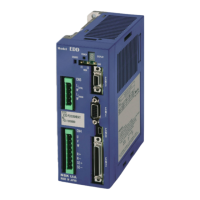Caution : The automatic tuning does not function if the following conditions are not
met. Confirm them before carrying out the automatic tuning.
• The load moment of inertia must be in the recommended range of the Motor. Refer
to “3.2.1.4. Confirmation of Use Conditions.”
• The Motor is set horizontally. (The load condition of the Motor must not be
affected by external force such as the gravity.)
• Mechanical rigidity of the Motor mounting base and an attached load to the Motor
is sufficient enough.
• There must be no backlash or play caused by gears or couplings.
• Frictional load to the Motor shall be minimal.
If the above conditions are not met, proceed to “5.3 Tuning Level 2: Servo
Gain Tuning.”
Preparation
You need to prepare the following for the automatic tuning.
Installation of the Motor. (Refer to “3.2.1.2. Motor Installation.”)
Attach the load to the rotor of Motor. (Refer to “3.2.1.3. Coupling Load to Motor.”
Installation of the Driver Unit. (Refer to “3.2.2. Installation of Driver Unit.”
Connection of the Motor and the Driver Unit. (Use the cable set provided with the Driver Unit.)
Refer to “3.3.1.Connection of Cable Set.”
Connection of the Handy Terminal.
Connection to AC power source. Refer to “3.3.2. Connecting Power.”
Wiring Servo ON (SVON) and Emergency stop (EMST) signal circuits.
(Connector CN2) Refer to “3.3.4. Connector Wiring.”
Fig 5-2: Wiring example of automatic tuning setup (reference only)

